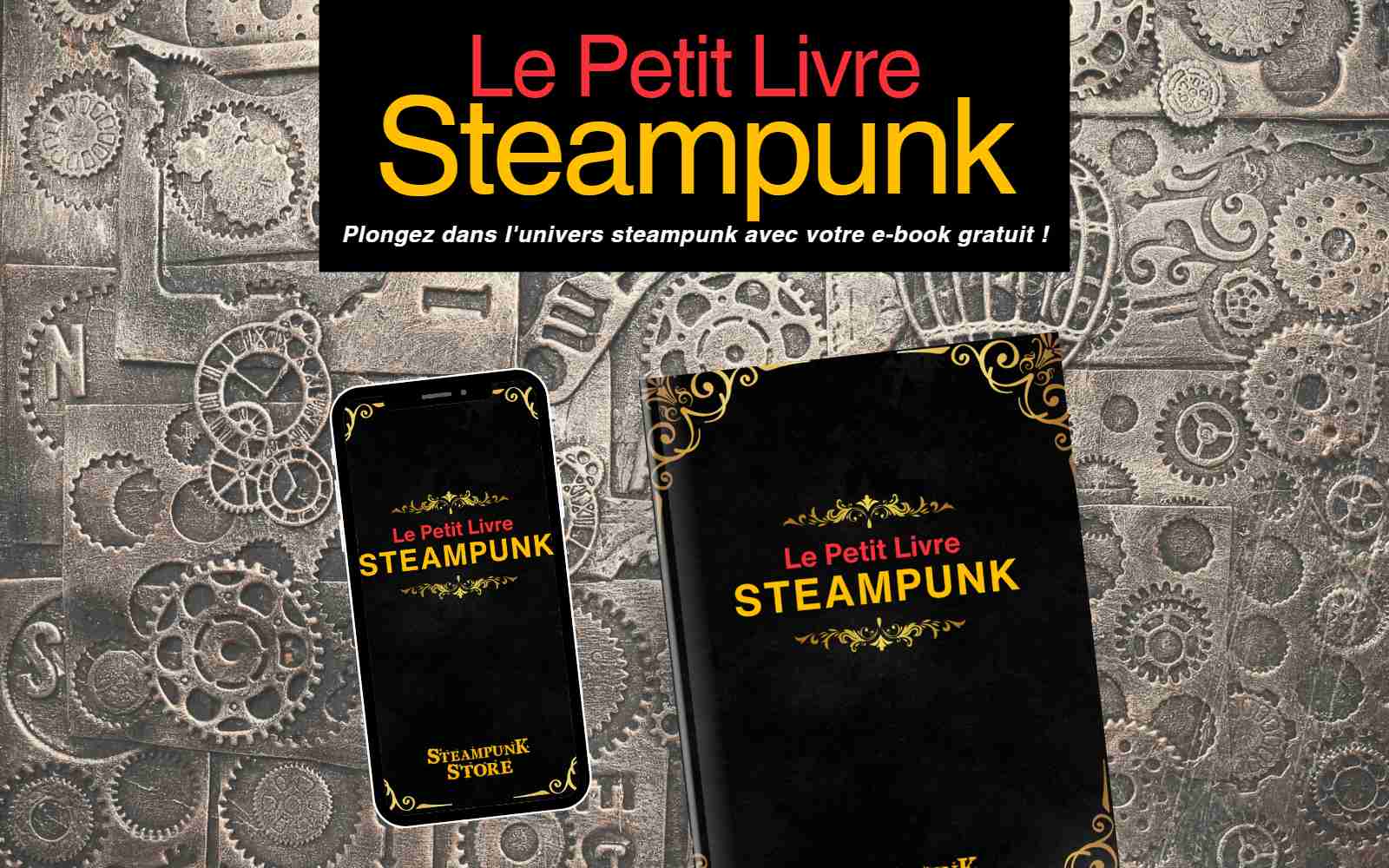
Welcome, my dear vaporists, to this new incursion into the sophisticated territories of steampunk fashion! We find ourselves at the heart of a theme that transcends mere coquetry: the analysis of steampunk dresses and their Victorian genesis. These garments, often dreaded for their reputation of discomfort inherited from the past, deserve a more nuanced approach. Did the bustiers, corsets, and other dresses of the 19th century truly evolve toward a harmonious synthesis between aesthetics and comfort? Let us return to the historical foundations and demystify the complex art of the steampunk dress.
Definition of the Steampunk Dress
The steampunk dress constitutes this remarkable synthesis between the aesthetic heritage of the Victorian era and contemporary design innovation. A direct heir to 19th-century creations, it preserves the sophisticated elegance of Victorian dresses while freeing itself from their most excessive constraints. This vestimentary alchemy harmoniously integrates corsets, bustiers, and mechanical ornaments to create a garment that celebrates both feminine beauty and technical ingenuity.
Sartorial Genealogy: The Steampunk Dress, Heir to the Victorian Era

Popular iconography, brilliantly illustrated by cinematic works like "Gone with the Wind," has crystallized in the collective imagination a somewhat caricatured vision of the Victorian feminine condition. This representation shows women desperately clutching bed posts while their servants mercilessly pull on corset laces to achieve that coveted wasp waist. This image, while evocative, cannot summarize the complexity of Victorian era fashion alone.
Certainly, it would be naive to deny that women actually suffered for aesthetic imperatives, much like our contemporaries with their vertiginous heels or cosmetic surgery procedures. The ridiculously wide crinolines, prominent busts, and metal-boned corsets undeniably limited freedom of movement and restricted the range of activities accessible to ladies of that era. However, this perspective constitutes only one facet of this rich sartorial history.
Socio-Cultural Context of Victorian Fashion
As sociologist Joanne Entwistle brilliantly highlights in her analysis of vestimentary systems, fashion is never mere ornamentation but a complex social language. The Victorian dress functioned as a sophisticated social communication mechanism, codifying status, morality, and class belonging with the precision of a measuring instrument.

This exploration traces the evolution of the feminine silhouette throughout the Victorian period, a metamorphosis facilitated by new social attitudes and revolutionary technological innovations. From crinolines to bustiers, through those corsets that sculpted the feminine torso, here's how these devices worn under clothing gave its distinctive form to Victorian fashion. The mechanisms invented to compress the waist created this optical illusion that made skirts appear fuller while harmoniously projecting the dress backward.
While numerous works have already explored in detail the role of the corset and crinoline in Victorian society, focusing largely on their deleterious effects on the female body, our analysis adopts a different perspective. We will explore how these undergarments actually affected the women who wore them, with the objective of dispelling popular rumors and opening minds to a more nuanced understanding. Our focus will primarily be on fashionable clothing, as this is where contemporary collections of corsets and steampunk dresses concentrate.
The Royal Alchemy: How Queen Victoria Transformed Fashion into a Social Machine
In 1837, like a clockwork mechanism starting up again, Victoria ascended to the British throne. The court naturally turned to this young sovereign to approve new fashions and become the aesthetic icon of her era, despite her youth. Contrary to popular belief, Queen Victoria manifested a real and pertinent interest in fashion, at least until the tragic disappearance of Prince Albert. This post-mortem period marked a radical turning point: traumatized by her mourning, she influenced the court toward a darker aesthetic, indulging in melancholic celebrations that prefigured our current gothic-steampunk blend.
The Royal Mourning Period: Genesis of Tenebrous Aesthetics
This aesthetic transformation marked the end of the flamboyant fashions of the mid-1830s, with their enormous balloon sleeves, grandiose bonnets, and extravagant ribbons. By the late 1830s and during the 1840s, the Victorian dress was characterized by its dropping shoulders, elongated pointed angles, and low-cinched waist. These low-waisted dresses required long reinforced-frame corsets to give them this particular silhouette. Contemporary steampunk dresses and gothic ones thus draw their roots from this dark and sophisticated period.
Technical Emancipation: When Corsets Free Themselves from Dresses
The corset of the 1840s represented a true feat of textile engineering, cut from separate pieces and assembled with clockwork precision to harmoniously sculpt the bust and shape the hips. A rigid frame, consisting of wooden plates and sometimes steel, was inserted on the front center of the corset, offering an impeccably smooth line to the dress bodice. Bone stays, veritable metal rods, were also inserted along the back and sometimes on the sides and front, giving architectural structure to the ensemble.

These corsets also had to possess sufficient rigidity to conceal the multiple layers of undergarments, including the chemise and petticoat, worn underneath. Period photographs testify to the daily discomfort of these long corsets, hardly bearable during entire days. In this revealing illustration, the female body appears maintained in a stiff and abnormally inclined position by a narrow-waisted corset that emphasizes the meticulous seaming of the bodice and the low waistline, like a sophisticated vestimentary mechanism.
Textile Metamorphoses: The Steampunk Dress as Victorian Heritage Reinvention
The skirts of the Victorian era presented their own technical and practical challenges. Their increasing amplitude required support by multiple layers of heavy petticoats, particularly uncomfortable and unhygienic, especially during summer periods. The support structures, crafted from down padding or whalebone and stiffened petticoats, contributed to creating this characteristic volume. The most popular type of stiffened petticoat was made from crinoline and linen, which earned it this denomination ("crin" for horsehair and "lin" for the linen thread of its construction). This textile crinoline should not be confused with its 1850s version in steel hoops, a revolutionary innovation we will explore further.
It becomes easy to understand the origin of this archetypal image of the docile and servile Victorian woman, with sagging shoulders and constrained gait, confined in her restrictive undergarments and multiple layers of heavy petticoats. However, one should not succumb to exaggeration. Photography and painting of the era adopted very studied poses, often representing models in their Sunday attire. Although corsets and heavy petticoats were manifestly worn, the lacing was probably loosened and petticoats lightened for daily wear, revealing a pragmatic adaptation to everyday realities.
The Industrial Revolution: Fashion Democratization and Mass Production Birth
The technological evolution of the late 19th and early 20th centuries generated a revolutionary selection of new undergarment models that, paradoxically, often facilitated women's lives while further complicating them. Simultaneously, new attitudes concerning health, comfort, and participation in sports activities allowed women to develop increased body consciousness and worry about potential harm caused by excessively restrictive undergarments.
The development of the sewing machine in the early 1850s constituted one of the most determining innovations of the 19th century, as it enabled mass production of men's and women's clothing and undergarments. Although many corsets of the 1850s were still hand-sewn, mechanical sewing speed allowed manufacturers to produce corsets in considerably increased quantities and increase the variety of available colors and models. Corsetry and undergarment manufacturing thus became a major industry generating several million pounds in annual revenue. However, in the 1850s, it was no longer so much the waist as the skirts that captured the attention of designers and the public.
Skirts constantly gained in amplitude, and lace ruffles as well as the light materials of their construction demanded increasingly structured support. The layers of petticoats, including crinolines, no longer sufficed and proved very heavy and uncomfortable. Something more architectural needed to be conceived. Contemporary steampunk dresses thus revisit these historical designs while striving to lighten and modernize the Victorian style, creating a harmonious synthesis between aesthetic heritage and modern comfort.
The Crinoline: Architecture of Distinction or Golden Cage?
The crinoline, a veritable architectural artificial cage, made its appearance in June 1856 as a revolutionary and more practical alternative. This innovation consisted of spring steel hoops, whose diameter progressively increased downward, suspended from cotton ribbons. This ingenious design possessed sufficient solidity to support skirts while creating this desired bell effect of the Victorian dress. Fashion enjoyed such success that the press dubbed this craze "Crinoline-mania," a veritable social phenomenon.

Spring steel structures also possessed remarkable lightness. Rather than imprisoning women in metal cages (as some sensationalist reports and illustrations suggest), they had an authentically liberating effect. They freed women from multiple layers of heavy petticoats and proved considerably more hygienic and comfortable. The contemporary press praised the virtues of these revolutionary crinolines with marked enthusiasm:
Period photographs reveal that many women wore more modest versions of the crinoline, as opposed to the gigantic bell-shaped creations so frequently observed in fashion illustrations. Large crinolines were likely reserved for balls, weddings, and other solemn occasions, functioning as veritable mechanisms of social theatricality.
The craze for the crinoline reached its peak in the late 1850s and early 1860s. After approximately 1862, the crinoline silhouette metamorphosed: instead of maintaining its bell shape, it became flatter in front and projected more toward the back. This eminently Victorian style is frequently reprised in current skirts and steampunk dresses for a deliciously vintage and sophisticated effect.
Contemporary Heritage: Steampunk Synthesis and Modern Innovation
My dear steampunk ladies, our exploration of this sartorial genesis reveals that the contemporary steampunk dress constitutes much more than a simple nostalgic reminiscence. It represents a sophisticated synthesis between the technical ingenuity of our Victorian ancestors and our modern understanding of comfort and functionality. Today's steampunk dress creators have masterfully succeeded in preserving the architectural elegance of Victorian silhouettes while eliminating their most excessive constraints.
This evolution testifies to our collective capacity to transmute the heritage of the past into contemporary innovations. Modern corsets offer the desired curve without compromising health, contemporary fabrics combine beauty and breathability, and current construction techniques allow freedom of movement unthinkable in the 19th century. Thus, wearing a steampunk dress today constitutes both an aesthetic and historical act: celebrating the beauty of the past while embracing the comfort of the present.
To deepen your understanding of this fascinating vestimentary universe, I highly recommend consulting our specialized guides on steampunk clothing for women and our exploration of contemporary corsets. Don't hesitate to also discover our selection of steampunk accessories that will harmoniously complete your retrofuturistic wardrobe.
May this exploration inspire you in your own vestimentary creations! For, remember, in the steampunk universe, we don't simply wear dresses: we display manifestos of mechanical beauty that transcend eras to celebrate the eternal alliance between tradition and innovation.
Thank you for sharing this article if it has captured your interest, and see you soon for a new incursion into the captivating territories of our steampunk universe!
Sources and References
- Entwistle, Joanne. "The Fashioned Body: Fashion, Dress and Modern Social Theory" (2000)
- Steele, Valerie. "The Corset: A Cultural History" (2001)
- Victorian fashion archives from the Victoria & Albert Museum
- Historical documentation on the evolution of the crinoline in the 19th century
- Studies on the social impact of the textile industrial revolution
- Contemporary analyses of steampunk and neo-Victorian fashion
Eugénie Vaporette
Curator-consultant in steampunk aesthetics
Graduate in Victorian technology history










